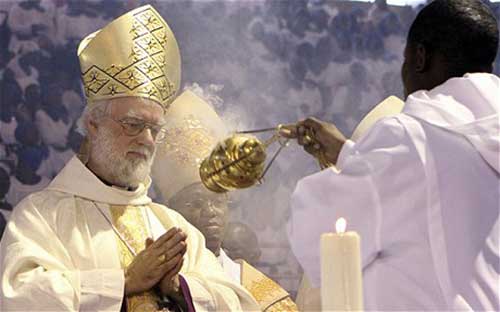Incense is used by Christians in many traditions. [It is used by other world faiths as well].
In Anglican history, incense is one of the “six points” of Ritualists, one of the streams that flowed into the catholic renewal of Anglicanism in the nineteenth century: altar candles, vestments, presiding facing East, wafer bread, adding water to the wine, and incense. Most of these are now normal in Anglican practice (excepting presiding facing East – in Anglicanism this was not a reaction against facing the congregation, it was in response to the misunderstanding of an Anglican rubric which had clergy “standing at the North side”, the short side of altars against the East wall, sideways to the people!) And, for some reason, incense is the last and least of the six to be used.
Now, however, at least in the UK, using incense is threatened not by a lurch away from catholic practice but by a Psychoactive Substances Bill in the UK Parliament. It would ban anything capable of “stimulating or depressing the person’s central nervous system” or which “affects the person’s mental functioning or emotional state”. Incense used in worship is not in the long list of exemptions.
Religious leaders have contended for millennia that burning incense is good for the soul. Now, biologists have learned that it is good for our brains too. An international team of scientists, including researchers from Johns Hopkins University and the Hebrew University in Jerusalem, describe how burning frankincense (resin from the Boswellia plant) activates poorly understood ion channels in the brain to alleviate anxiety or depression. This suggests that an entirely new class of depression and anxiety drugs might be right under our noses… To determine incense’s psychoactive effects, the researchers administered incensole acetate to mice. They found that the compound significantly affected areas in brain areas known to be involved in emotions as well as in nerve circuits that are affected by current anxiety and depression drugs.
Spiritual and religious practices often have a surprisingly down-to-earth foundation, and they regularly connect with scientific understandings of the way we function as a whole person. Making the Sign of the Cross and singing both involve both hemispheres of the brain – enhancing devotion. Incense would have covered the stench of temple sacrifice, and that of the unwashed crowds in religious (and non-religious) events. We may be too quick to allegorise incense as a sign of prayers going up to heaven. Incense may have a much clearer place in devotional life.
What is incense for? For the nose? For the brain?
That is – if it stays legal!
If you appreciated this post, consider signing up for a not-very-often email, and/or like the liturgy facebook page…




I think you’re right – a lot of ritual has it’s origin in a pragmatic, realistic understanding of who we are as human beings (including the fact we’re smelly!).
But in a more spiritual sense, I love coming into an empty church and catching the faint smell of incense.
A sign of presence.
I understood that generating smoke inside confined spaces had been illegal for some years?
(For an asthmatic, incense does as much harm as cigarette smoke)
Not sure which country, James, you are in where, say, burning an incense stick inside is illegal. So presumably selling them in your country is also illegal? Or do they come with a warning to only burn them outside in your country, or you are breaking the law?
And could you point to the study of the health issues so we can be clearer: is being present, say, in St Peter’s in the Vatican when incense is used at the altar, as harmful as smoking how many cigarettes, or are you saying something else?
Blessings.
Well this is what came to mind… https://www.youtube.com/watch?v=DM8mDeFeWZ4
Christ’s? 😉
Certainly on Easter Day last year at St Francis, Tokoroa, when the priest decided to use incense (which was not usually used) he had to quickly abandon it as one member of the congregation who has asthma/lung issues found she could not breathe. Sad but true. I have heard a similar comment from someone at my church here in Dunedin.
Great article! Blessings. Love incense, even if sometimes used too liberally!
I’ve only seen it used once and that was at a service in Newcastle in Oz. All very lovely with the sun streaming and making patterns in the air. I’m sure God was present with individuals based on need or desire irrespective of the smoke so its arguably ritual that we do not need no matter how nice it looks. What I recall more clearly was the floating stuff in the communion cup. The science around it being good for you is interesting though.
Incense is an integral part of every Catholic Solemn Eucharist or High Mass and of every Catholic funeral. What would we do without it? I suppose common sense is needed re small spaces or hypersensitive lungs.
In the US, many PC invites to meetings and events even ask folks to refrain from splashing on the aftershave and cologne!
LOL! Br David – I’ve never heard of that! There’s a doctoral thesis waiting to be done: seeing if there is any correlation between position on the protestant theological spectrum and allergy to incense 😉 Blessings.